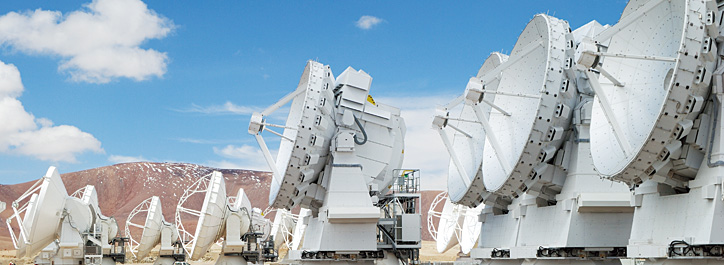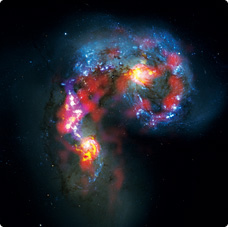
12m (39-ft.) and 7m (23-ft.) antennas on the Atacama Plateau. As of September 2012, 40 antennas had been installed. By the end of 2013, the remaining 26 antennas will be added. (Photo: Courtesy of National Astronomical Observatory of Japan)
Like an insect’s compound eye, the Atacama Large Millimeter/submillimeter Array (ALMA) is a group of receptors — 66 parabolic “dish” antennas — that work together to collect data to create images. Perched 5,000m (16,404 ft.) above sea level on the Atacama Plateau in Chile, ALMA is a high-performance radio telescope capable of observing millimeter and submillimeter wavelengths with unprecedented sensitivity and spatial resolution. ALMA, a collaborative project among nations in East Asia, North America, Europe and Chile, began scientific observations in 2011. Although all of its 66 antennas will not be installed until the end of 2013, it is scheduled to start full operations before April that year. Astronomers have high hopes for what it will reveal in the universe.
What Is a Radio Telescope?
An optical telescope, with its long body, lenses and/or mirrors, observes objects using visible light, which has a wavelength of about 380–780 nanometers. However, there are other kinds of light in the electromagnetic spectrum, each with a different wavelength: gamma rays, X-rays, ultraviolet rays, infrared rays and radio waves. Radio telescopes observe radio waves, which have wavelengths ranging from 0.1mm to 15m (0.004 in. to 50 ft.) and are emitted by many astronomical objects, such as galaxies, nebulae and even planets.
Dr. Masaaki Hiramatsu, an assistant professor of the Chile Observatory, National Astronomical Observatory of Japan (NAOJ), says the night skies are deceiving. “When we look up at the stars, we see black space between them. We think there’s nothing there, but gas, dust and other objects are present. Their temperatures are very low, so they do not emit visible light. They emit radio waves at millimeter or submillimeter wavelengths, longer than visible light. So, to observe what we cannot see, we need a radio telescope that catches such radio waves from space.”
Karl Guthe Jansky, an engineer at Bell Telephone Laboratories in the United States, built the first radio telescope, quite by accident, in 1931. Trying to identify sources of static, he built an antenna system that could scan 360 degrees. After a few months, he identified three types of static, including one from an unknown source. Janksy deduced that the radiation was coming from the Milky Way.
The Japanese have also made many contributions to radio telescope technology. For example, the Nobeyama Radio Observatory in Nagano prefecture, which began operations in 1982, has a 45m (147-ft.) telescope that can detect radio waves at shorter wavelengths (3–20mm/0.1–0.8 in.). It was designed to study star formation and interstellar matter. Though it performs well, it has one surprising disadvantage: It is too small. In order to see objects in greater detail, researchers had to devise a system much bigger than that at Nobeyama — or any other on the Earth.
ALMA: A Powerful Eye on the Universe

The Antennae Galaxies located about 70 million lightyears from Earth in the direction of the constellation Corvus. The picture is a composite of two types of observation data, one acquired during a preliminary test observation with the ALMA system (millimeter radiowave) and one obtained by the Hubble Space Telescope (visible light). The Antennae Galaxies are two spiral galaxies being transformed by collision. Hubble’s visible light (blue) shows only newborn stars, but the radiowaves detected by ALMA show high-density, low-temperature gas (red, pink and yellow), which scientists believe eventually form stars. Gigantic gas clouds are clearly visible at the centers of each galaxy and in the areas where they intermingle.
[Photo: Courtesy of ALMA (ESO/NAOJ/NRAO), NASA/ESA Hubble Space Telescope]
The Atacama Plateau was the perfect location for ALMA. It is large and flat. It gets less than 100mm (4 in.) of rainfall per year, which is important because atmospheric moisture absorbs and scatters millimeter and submillimeter radio waves. Also, Chile is ideally situated for clear observation of objects in the southern sky, such as the center of the Milky Way.
ALMA is an interferometer system, meaning antennas are connected to function as one huge instrument. It is also designed to form different configurations for different purposes. The antennas, transportable by huge vehicles, can be positioned across an area as large as 18.5km (11.5 mi.) to achieve high resolving power or are placed closely together to achieve higher sensitivity.
Fifty antennas, each 12m (39 ft.) in diameter, make up ALMA’s core; Dr. Hiramatsu, who describes these antennas as the “eye,” says they have a resolution about 10 times greater than NAOJ’s Subaru Telescope in Hawaii or the Hubble Space Telescope. But this eye “will not give a completely clear view of the diffuse gas clouds in space,” he says. To fill in this “blind spot,” Japan developed the Atacama Compact Array (ACA). “ACA comprises four 12m (39-ft.) parabolas and twelve 7m (23-ft.) parabolas,” he explains. “They enable observation of widely spread gaseous space. By combining data from all 66 parabolas, we can obtain super-high-resolution images of widely spread structures in space.”
Japan also developed a high-performance correlator to process the data ACA acquires, as well as devices to receive three radio wave frequency bands, two of which deal with the submillimeter frequency range.
Dr. Hiramatsu states that ALMA has three goals: to understand the birth of galaxies, observe the birth of planetary systems and discover matter that relates to the origin of life. “ALMA will enable us to observe almost everything in the universe, from our own sun to the distant history of the universe and the afterglow of the Big Bang,” he explains. “I am expecting huge breakthroughs to come in every field of astronomy.”
- 1. Insects: Eyes that See the World in a Different Way
- 2. Our “Super Vision” into the Universe
- 3. The K computer: A New Way of Looking at the World

